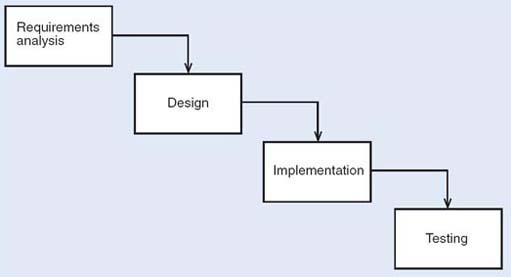2.2 From waterfall to iterative development
Historically, the first widely adopted software development process was the waterfall development process (or simply, waterfall).
The waterfall process relies on the definition of sequential phases, as shown in Figure 1. Each phase starts only after the previous one has finished; all the analysis is done first, followed by all the design, then the implementation, and finally the testing.
The waterfall process has been widely used and has produced many successful software products. However, it makes several assumptions that have been criticised.
For example, it relies on the existence of a set of requirements that is defined beforehand and remains unchanged during development; it also assumes that all code is designed from scratch, making no allowance for the reuse of existing software. Because the development is carried out as a linear process, the waterfall process does not allow previous phases of the development to be repeated without repeating the whole sequence of steps.

Exercise 2
-
What are the disadvantages of developing software in strict sequence through all its development phases?
-
Can you think of an advantage, from a management point of view, of developing the software in strict sequence?
Answer
Solution
-
The results of implementation and testing may lead to refinements in the requirements specification that are difficult to accommodate in a strictly sequentia development. The period of development is long, any feedback on the requirement comes too late, and the requirements may then no longer be valid.
-
The development process can be easily controlled, and it is easy to know when each phase has been completed, and to estimate the total length of the project.
The waterfall process is an important approach which has been widely applied in the past. However, its rigidity in the face of changes and its lack of support for reuse make it unsuitable for modern enterprise systems development, where coping with continuous business changes and short time-to-market is paramount. The inevitability of revisiting requirements to address problems identified earlier rather than later has led to processes that allow for a repetition of early phases before the end of development.
Iterative and incremental processes represent best practice that has been identified from the limitations of the waterfall process. The term ‘iterative’ indicates the repetition of one or more activities; the term ‘incremental’ indicates that development proceeds from an initial subset of the requirements to more and more complete subsets, until the whole system is addressed. Incremental development involves an initial partition of the intended functionality; some or all of the subsequent development activities can be carried out independently and in parallel. The final product results from the total integration of the partitions.
In iterative and incremental processes there is still a need for analysis, design, implementation and testing activities, but these activities are carried out in a more flexible way than in the waterfall process. An iterative and incremental process consists of several cycles of analysis, design, implementation and testing. Each cycle is short and provides feedback for the next cycle, in which a more refined and enhanced development is achieved. With an incremental model, development starts from small subsets of the requirements, reducing the complexity and scope of each analysis, design and coding cycle. Each increment is carried through the development activities to produce a working subset of the system, and is developed through several iterations. The integration of the increments results in the final system. However, this integration can be progressively achieved by successive releases of the software, each release achieving more functionality. Figure 2 illustrates an iterative and incremental model The increments represent development that can be carried out independently and in parallel. It should be stressed that the activities within each iteration are not necessarily sequential. Testing, for example, is no longer an activity that takes place only after implementation has terminated; tests start being developed as early as the analysis stage.

As each cycle deals with a small set of requirements, the complexity of each increment is managed; the complexity of the whole system needs to be managed by progressive integration of increments. Early feedback is obtained from a partial implementation. This implementation can be assessed early and may lead to alterations to some requirements or the completion of others. Reuse is also encouraged by partitioning the initial set of requirements, because it will be easier to identify reusable components that match requirements within each such partitioning.
Exercise 3
-
Why is early feedback, provided by each iteration, an advantage?
-
Can you think of any disadvantages that may be associated with an iterative and incremental development cycle?
Answer
Solution
-
It allows development effort that is going down a blind alley to be detected and halted.
-
It is difficult to know when to stop iterating; the integration of the partitions requires very careful definition of the interaction between these partitions.
